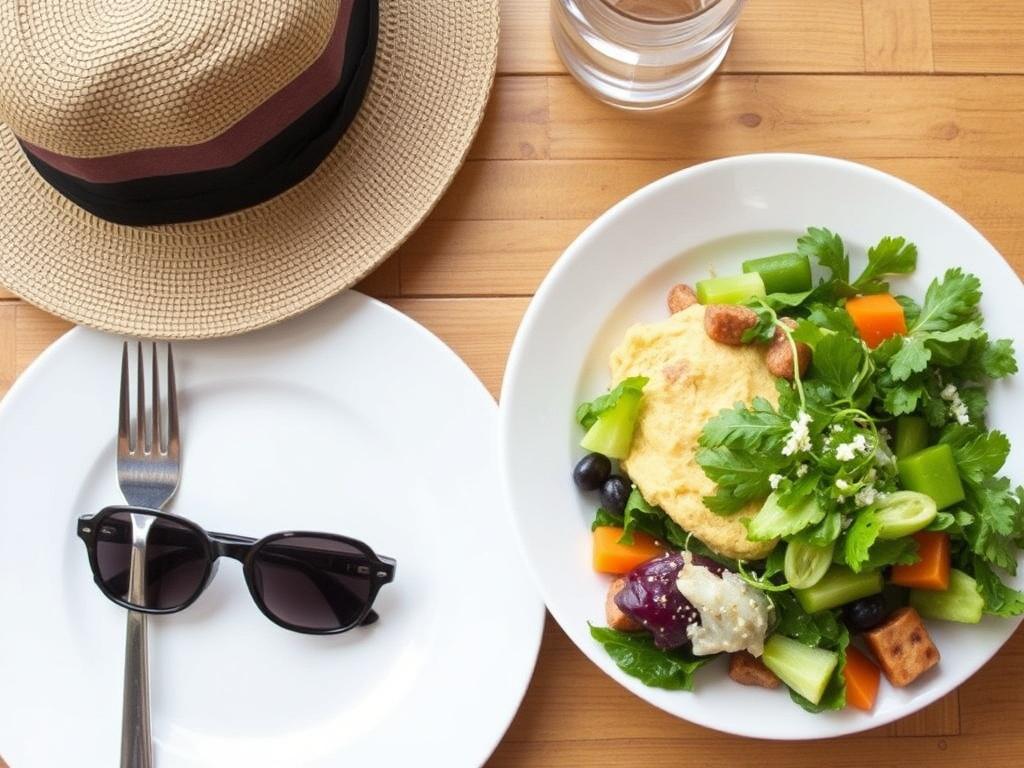
How to Travel with a Vegan Diet: Your Ultimate Guide to Delicious and Stress-Free Journeys
SQLITE NOT INSTALLED
Traveling is one of life’s greatest joys—new places, new cultures, new experiences. But if you follow a vegan diet, the excitement can quickly turn into a source of stress and confusion. How do you maintain your plant-based lifestyle while on the road? How do you find vegan-friendly meals in unfamiliar places? What about snacks, airports, and long journeys? Don’t worry, you’re not alone! Traveling with a vegan diet is entirely possible with the right preparation, mindset, and knowledge. In this comprehensive guide, we’ll explore everything you need to know so you can enjoy your adventures and stay true to your values and health.
Understanding the Challenges of Traveling as a Vegan
The first step in learning how to travel with a vegan diet is knowing the common obstacles you may face. Unlike eating at home, where you have full control over ingredients and cooking methods, traveling often means relying on restaurants, convenience stores, or public eateries. Not all places are vegan-friendly, and language barriers can make communicating your dietary needs tricky. Sometimes, you might find that popular or traditional dishes in a destination rely heavily on animal products, leaving limited options for vegans.
Another challenge is nutritional balance. When on the go, it’s easier to fall into the trap of grabbing quick fixes like fries or processed snacks that are vegan but not very nutritious. Finally, the unpredictability of travel schedules—early flights, delayed transport, or overnight buses—can disrupt your regular eating patterns. Being prepared to handle these challenges is key to making vegan travel stress-free and enjoyable.
Planning Ahead: Research and Preparation
One of the best ways to ensure success while traveling on a vegan diet is thorough research before you leave. Thanks to the internet and apps, you can scout out vegan restaurants, grocery stores, and markets in your destination city beforehand. Many cities now have flourishing vegan scenes, with dedicated cafes and shops that cater specifically to plant-based diets.
Vegan-Friendly Apps and Resources
To simplify your planning, consider using the following tools:
- HappyCow: This app lists vegan and vegetarian restaurants globally, along with user reviews and photos.
- Google Maps: Use keywords like “vegan,” “vegan-friendly,” or “plant-based” combined with the location to find nearby eateries.
- Local Vegan Blogs: Many cities have bloggers who cover the vegan dining scene in detail.
- Language Translation Apps: Useful for explaining your vegan diet in different languages if you’re traveling internationally.
Packing Smart: Vegan Travel Essentials
Packing snacks and simple ingredients can save you from hunger during long transit times or when vegan options are scarce. Here’s a handy table to guide your packing list:
| Snack/Item | Reason to Pack |
|---|---|
| Trail mix (nuts, seeds, dried fruit) | Nutritious, energy-dense, non-perishable |
| Energy bars (check for vegan labels) | Quick, convenient, filling |
| Nut butters (single-serving packs) | Good protein source, pairs with fruit or crackers |
| Instant oatmeal packets (vegan-friendly) | Easy breakfast with hot water |
| Reusable water bottle | Stay hydrated and reduce plastic waste |
| Reusable cutlery and food containers | Helps you eat takeout safely and sustainably |
Eating Vegan While in Transit
Whether you’re on a plane, train, or road trip, maintaining your vegan diet during transit is doable with a bit of planning. Airlines often have special meal requests for vegans, so it’s a good idea to request vegan meals in advance, ideally at the time of booking or at least 48 hours before flying. However, don’t rely entirely on airline meals—bringing your own snacks can keep hunger at bay and give you peace of mind.
At airports or stations, look for fresh fruit vendors, salad bars, or sandwich shops that offer vegan choices. Carrying a small cooler bag or insulated pouch can help keep fresh foods like fruits or veggie sandwiches safe until you’re ready to eat.
Tips for Long Flights
- Confirm your vegan meal request with the airline immediately after booking.
- Bring your favorite vegan snacks in your carry-on.
- Hydrate well and avoid alcohol or caffeine, which can dehydrate you.
- Research airport lounges that offer vegan snacks—some have more options than public areas.
Finding Vegan Food at Your Destination
Once you arrive, one of the best parts of travel can be exploring local cuisine. Yet, when you eat vegan, you’ll need to get a little creative and adventurous. Many traditional dishes aren’t made vegan in their authentic form, but with so many cultures embracing plant-based eating, you’ll definitely find tasty options.
How to Identify Vegan Dishes
Some cuisines naturally lend themselves to vegan eating, such as:
- Indian (many vegetable curries, lentils, rice dishes)
- Middle Eastern (hummus, falafel, tabbouleh)
- East Asian (tofu dishes, vegetable stir-fries, rice and noodle bowls)
- Mexican (beans, guacamole, rice, salsas, corn tortillas)
Most menus will list ingredients, but if they don’t, you can learn to recognize common animal-derived ingredients: cheese, butter, cream, eggs, fish sauce, meat broths, gelatin, honey. Using a translation app with vegan phrases can be a huge help, especially if you can show the phrase in the local language to the waiter.
Dining Out Tips
- Look for vegan or vegetarian-friendly restaurants on apps like HappyCow.
- Call or email restaurants ahead to ask about vegan options.
- Don’t be afraid to customize dishes, like asking for no cheese or butter.
- Try street food vendors who specialize in vegetable or legume-based snacks.
Accommodation and Cooking Your Own Vegan Meals
Sometimes, eating out may not be your preferred option or budget. Booking accommodation with a kitchen can be a game-changer for traveling vegans. Many hostels, Airbnbs, and vacation rentals offer kitchen facilities or at least a mini-fridge and microwave. With access to a kitchen, you can shop local markets and create your own nutritious, plant-based meals.
Shopping for Vegan Ingredients Abroad
Depending on where you travel, not all ingredients may be readily available. Staples such as rice, beans, lentils, and local vegetables usually are. You may need to adapt recipes based on what produce you find.
Foods to look for at markets or supermarkets include:
- Fresh fruits and vegetables
- Legumes and pulses (lentils, chickpeas, black beans)
- Tofu, tempeh, or other soy products (common in East Asia)
- Grains like rice, quinoa, bulgur, or pasta
- Nuts, seeds, and dried fruits
Equipping Your Travel Kitchen
If you know you’ll be cooking during your trips, consider bringing a few travel-friendly cooking essentials:
- Compact cutting board
- Small sharp knife (check airline rules)
- Spices and seasoning packets
- Small portable stove or electric kettle (if allowed)
- Reusable containers for leftovers
Staying Healthy and Balanced on a Vegan Diet While Traveling
Travel is exciting but can also throw off your nutritional routine. Maintaining a balanced vegan diet means paying attention to certain nutrients that can be harder to get, especially when eating out or eating convenience foods.
Key Nutrients to Monitor
| Nutrient | Sources on Vegan Diet | Tips While Traveling |
|---|---|---|
| Protein | Legumes, tofu, tempeh, nuts, seeds, whole grains | Carry nuts, beans, or vegan protein bars for snacks; seek out traditional legume dishes. |
| Vitamin B12 | Fortified plant milks, supplements | Carry vitamin supplements or fortified foods to avoid deficiency during travel. |
| Iron | Spinach, lentils, chickpeas, pumpkin seeds | Eat vitamin C rich fruits alongside iron sources to improve absorption. |
| Calcium | Fortified plant milk, tofu, leafy greens | Seek out fortified products or consume greens often. |
| Omega-3 Fatty Acids | Flaxseeds, chia seeds, walnuts | Include seeds or nuts daily, carry them as snacks. |
Dealing with Social Situations and Cultural Differences
Sometimes the biggest challenge of traveling with a vegan diet isn’t the food options—it’s the social scenario. Eating with friends, family, or locals might come with pressure to “try something” or confusion about your choices. Here’s how to navigate these moments smoothly:
- Communicate Clearly: Share your reasons for being vegan respectfully but firmly.
- Offer to Bring a Dish: If invited to a meal, contribute a vegan dish you know and love.
- Be Open to Trying Local Vegan Dishes: Show interest in the local vegan cuisine to connect with your hosts.
- Prepare Mentally: Accept that you may need to politely decline certain foods without feeling guilty.
Tips for Different Types of Travel
Vegan travel can look very different based on your mode of travel, destination, or length of stay. Here are tailored tips for various scenarios:
Road Trips and Camping
- Pack plenty of non-perishable, high-energy snacks like nuts, dried fruits, and energy bars.
- Bring a portable stove or grill to cook meals.
- Use coolers for fresh produce, tofu, or plant-based dairy products.
- Plan campsites or rest stops near grocery stores or vegan-friendly diners.
International Travel
- Learn how to say “I am vegan” or “no animal products” in the local language.
- Use translation cards or apps to clarify menu items.
- Equip yourself with snack packs since airport or train station food can be limited.
- Research local vegan customs or popular dishes beforehand.
Business Travel
- Request vegan meals on flights and hotels as part of your reservation.
- Carry quick snacks to avoid unhealthy or non-vegan options during tight schedules.
- Network with local vegans or use apps to find lunch spots near your meetings.
- Politely inform hosts or colleagues about your diet when dining socially.
Backpacking and Budget Travel
- Rely on local markets for fresh fruits, vegetables, grains, and legumes.
- Choose accommodations with kitchen access to prepare your own meals.
- Explore street food options with a vegan twist.
- Join online vegan travel communities for tips and support.
Vegan Travel Success Stories and Inspiration
Many travelers have embraced the challenge of vegan travel and come back with incredible stories of discovery, delicious food, and warm community connections. From vegan food trucks in bustling cities to homemade meals shared in rural homestays, vegan travel opens doors to unique cultural experiences.
One travel blogger described how they found a hidden vegan paradise in a small town in Italy, where the chef prepared a special plant-based menu by request. Another traveler shared how navigating street markets in Thailand with basic language skills led them to discovering countless naturally vegan dishes.
Inspiration like this shows that planning, openness, and patience can turn traveling with a vegan diet into a rewarding adventure rather than a burden.
Conclusion
Traveling with a vegan diet may come with extra planning and occasional challenges, but it’s entirely doable and can enrich your travel experience in surprising ways. Whether you’re exploring vegan-friendly cities, cooking in a rented kitchen, or simply relying on your trusty snack stash, a plant-based lifestyle on the road encourages mindfulness, creativity, and connection to local cultures and foods. By researching ahead, packing smartly, and being open to new flavors and experiences, you can enjoy smooth, delicious, and healthy journeys as a vegan traveler. Remember, every trip is a chance to grow, learn, and savor the vibrant world of vegan cuisine waiting for you—wherever you go. Safe travels and happy eating!




